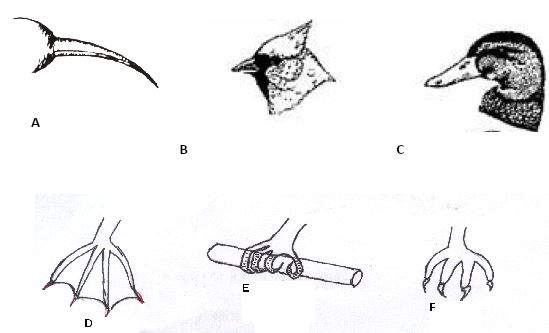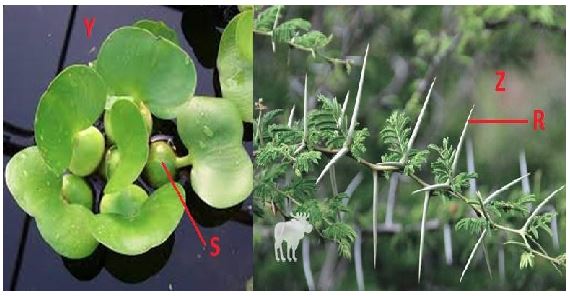Instructions
- Answer all questions
- You are provided with specimen labelled A. Obtain a cube measuring 1cm by 1cm from the specimen.
-
- Crush the cube using mortar and pestle, place the crushed parts in measuring cylinder, add 2 ml of hydrogen. Identify the process and eplain why this reaction occurs in living cells (2 marks)
- Write an equation of the reaction above (1mk)
- You are provided with a solution labeled B, unboiled C1 and boiled C2. Place 2ml of the solution B into two test tubes and carry out a food test using the reagents provided. Record your observation in the table below.
FOODSUBSTANCEPROCEDURE OBSERVATION CONCLUSION
Place 2ml of solution B into four test tubes labeled F, G, H and K. Carry out the following steps.- To test tube labeled F and its contents add 3ml solution C1 and 3 ml distilled water.
- To test tube labeled G and its contents, add 3ml solution C1 and 3 ml dilute hydrochloric acid
- To test tube labeled H and its contents, add 3 ml solution C 1 and 3 ml sodium hydroxide solution.
- To test tube labeled K and its contents, add 3 ml solution C2.
- Place the test tubes in a water bath at 37 0C for 20 minutes.
- Carry out a Benedict’s test and fill the table below. (4 marks)
Test tubePROCEDURE OBSERVATION CONCLUSION F G H K
- Account for the observation in:
- Test tube G. (2 marks)
- Test tube H. (1 mark)
- Test tube K. (2 marks)
- Why was the water bath maintained at 37°C? (1mark)
-
- The diagrams below represent body parts of some organisms (animals). Study them and answer the question that follow.
-
- Suggest the type of food eaten by organisms with the parts labeled A, B, C and F
Food Reason
A
B
C
F (4mks) - With reasons, suggest the likely habitat of the organism from which the parts labeled D and E were obtained (2mks)
Part Habitat Reason
D
E
- Suggest the type of food eaten by organisms with the parts labeled A, B, C and F
-
- Suggest the type of evolution that is exemplified by the organisms labeled D, E and F. Give reason for your answer
The type of evolution (2mks)
Reason - Suggest the significance of the above named type of evolution for the organism(1mk)
- Suggest the type of evolution that is exemplified by the organisms labeled D, E and F. Give reason for your answer
-
- Explain briefly the meaning of analogous structures (1mk)
- Give one example of analogous structure (1mk)
-
- You are provided with specimens labelled:
J: Hibiscus rosaninensis
K: Bougainvillea glabra
L: Jacaranda mimosifolia
M: Zea mays
N: Lantana camara- Using the characteristics given below and in the order in which they occur, construct a dichotomous key to identify the specimens.(8mks)
Characteristics- Type of leaf
- Leaf venation
- Leaf margin
- Texture of leaf lamina
-
- Identify the likely habitat of the plant from which specimen labelled N was obtained from. (1 mrk)
- Give a reason for your answer in bi) above. (1 mrk)
-
- Name the class of the plant from which specimen M belong. (1 mrk)
- Give a reason for your answer in c i) above. (1 mrk)
- Study the photographs below depicting plants growing in different habitats.
- Identify the habitats in which they are found (2mks)
- State the significance of the following structures found in the specimens shown above (1mrk)
- Using the characteristics given below and in the order in which they occur, construct a dichotomous key to identify the specimens.(8mks)
MARKING SCHEME
-
-
- Detoxification
- Toxic substances in the body broken down to less toxic substances like water and Oxygen to prevent harm to the body
Enzyme catalase
Hydrogen Peroxide--------------------------------Water +Oxygen
- Toxic substances in the body broken down to less toxic substances like water and Oxygen to prevent harm to the body
- Detoxification
- 1st table
FOODSUBSTANCEPROCEDURE OBSERVATION CONCLUSION Starch Add 2 drops of iodine solution Blue -Black Starch present Reducing sugar Add equal amount of Benedict`s solution
Heat to boilBlue colour remains Reducing sugar absent
2nd table
Test tubePROCEDURE OBSERVATION CONCLUSION F Add equal amounts of Benedict’s solutionHeat to boilBlue-Green-Yellow - OrangeReducing sugar presentG Add equal amount of Benedict`s solution
Heat to boilBlue-Green-Yellow-Orange Reducing sugar presentH Add equal amount of Benedict`s solutionHeat to boilBlue-Green-Yellow- Orange Reducing sugar present K Add equal amount of Benedict`s solutionHeat to boilBlue colour remains Reducing sugar absent -
- Account for observation in
Test tube G-- Reducing sugar was absent
- Hydrochloric acid creates acidic conditions which are not favourable for enzyme amylase
- Test tube H-
- Reducing sugar present because C1 works well under alkaline conditions hence breaks down starch to maltose
- Test tube K
- Reducing sugar was absent because boiling denatured the enzyme amylase
- Why water bath maintained at 37°C-
- Because enzymes work well at optimum temperature
- Account for observation in
-
-
-
- Suggest the type of food eaten 4mrks
Food eaten Reason A Nectar Long, thin/slender beak for probing into the flower to suck nectar B Grains/cereals/seeds Strong beak for cracking seeds C Pondweeds/waterweeds/worms/cereals Flat, serrate for filtering food from the water F Flesh/meat Pointed claws for seizing meat - 2mks
Part Habitat Reason D Aquatic Webbed feet for swimming E Terrestrial Pointed/sharp claws for seizing /hooking the prey
- Suggest the type of food eaten 4mrks
-
- Suggest the type of evolution labelled D, E and F
- Divergent evolution
- Significance of divergent evolution
- Enhances the organisms to occupy different ecological niches
- Analogous structures-are structures that have different embryonic origin but have evolved to perform similar functions due to exploitation of the same kind of environment.
Example are wings in birds having the pentadactyl structures while in insects the wings have veins composed of cuticle
- Suggest the type of evolution labelled D, E and F
-
-
-
-
- Leaf simple………………………………………go to………2
- Leaf compound……………………………… Jacaranda mimosifolia
-
- Leaf parallel veined…………………………… Zea mays
- Leaf net veined………………………………… go to ….3
-
- Leaf margin entire…………………………. Bougainvillea glabra
- Leaf margin serrate……………………………… ………4
-
- Lamina texture rough hairy……………………Lantana camara
- Lamina texture smooth………………………… Hibiscus rosaninensis
-
-
- Identify the likely habitat of the plant labelled N
- Terrestrial
- Reason
- Hairy cuticle that prevents excessive transpiration
- Identify the likely habitat of the plant labelled N
-
- Class of plant M
- Monocotyledonae
- Reason
- Parallel veined
- Class of plant M
-
- Habitat of:
- Y - Aquatic
- Z - Arid /semi-arid areas
- Significance of R
- Thorns Protects the plants from being fed by animals
- Habitat of:
-
Join our whatsapp group for latest updates
Tap Here to Download for 50/-
Get on WhatsApp for 50/-
Download Biology Paper 3 Questions and Answers - Lugari Constituency Joint Pre Mock Exams 2023.
Tap Here to Download for 50/-
Get on WhatsApp for 50/-
Why download?
- ✔ To read offline at any time.
- ✔ To Print at your convenience
- ✔ Share Easily with Friends / Students


